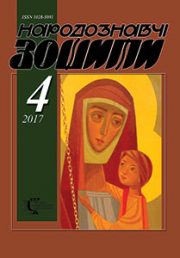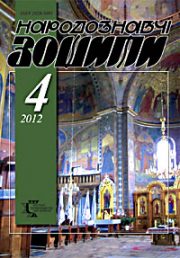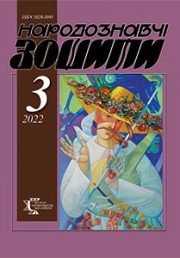The Ethnology Notebooks. 2021. # 2 (158), P. 342—354
УДК [39-047.37:[624-051 В.Турчиняк:726.54]:930](477.85/.86-22)
DOI https://doi.org/10.15407/nz2021.02.342
Yaroslav TARAS
- ORCID ID: https://orcid.org/0000-0001-7241-9466
- Doctor of Historical Sciences, Professor,
- Institute of the Ethnology of the National Academy of Sciences of Ukraine,
- Head of the Department of Modern Ethnology,
- 15, Svobody Avenue, 79000, Lviv, Ukraine,
- e-mail: etnomod@ukr.net
VASYL TURCHINYAK AS A BUILDER OF ST.YURIY CHURCH IN THE VILLAGE DULIBY OF THE STRYI DISTRICT
The idea of writing an article appeared during the elaboration of sources for historical and cultural essay about the village Duliby of the Stryi district. In publications devoted to master V. Turchinyak, the Duliby’s Church of St. Yuriy building, there are a number of provisions for which I am as a historian, architect must react, highlight your vision of this figure. The relevance of the topic is outlined.
The purpose of the publication is to consider extensive historiography, to highlight the current state of study of life and artistic heritage of the builder Vasyl Turchinyak from Lug Nadvirna district. The source base of the article is analyzed works devoted to V. Turchinyak, from the end of the XIX century to the present.
For the first time talked about the master at the end of the XIX century, after he was visited by a well-known public figure and ethnographer Volodymyr Shukhevich. It has been established that the study of creativity of master V. Turchinyak activated at the end of XX — early XXI century. This determines the chronological limits of our research.
The participation of V. Turchinyak, Dulibian community and masters in the construction of the Church of St. Yuriy in the village of Duliby is expressed in detail.
The role of Father M. Datsishina in resurrection of memory of the prominent master, in the dissemination of information about the Dulib’s Church of St. Yuriy is relevant.
It is shown what was based on the talent of the master V. Turchinyak, which allowed him to organically combine architectural and constructive elements with the artistic, as he adapted the traditional thread to the requirements of sacred monumental art, created a distinctive style. It was found that the master V. Turchinyak, as most of the folk masters, was endowed with supernatural abilities, as widespread revision of his beliefs, divination, providence.
It is stated that in many today’s publications, we have a valid historical and cultural reality of the creativity of V. Turchinyak, and a variety of oral folklore, in which his figure is grown by weight, people poetize the master who loves and wants to be shown wiser than architect, engineer, mister.
The research methodology is based on theoretical analysis, systematization and generalization, historical examination and observation of the author.
Keywords: Master V. Turchinyak, Church of St. Yuriy in Duliby, Hutsulshchyna, Boykivshchyna.
REFERENCES
- Shukhevych, V. (1899). Kunistas. Dilo (Part 26) [in Ukrainian].
- (1936, 9.II). Illustrated chronicle: The weekly magazine of the New Age [in Polish].
- Lahodyns’ka, H. (1938). Treasures of art in quiet corner. Nasha Bat’kivschyna (Part 11). L’viv [in Ukrainian].
- (1964). Ukrainian Soviet Encyclopedia (Vol. 15). Kyiv: Holov. red. URE [in Ukrainian].
- (1964, 17.03). This was his fate. L’vovskaia pravda [in Ukrainian].
- Kyryliuk, H. (1957). The fate of Vasyl Turchinyak: Promotions. Kyiv: Molod’ [in Ukrainian].
- Flys, S. Carver from God. Lvivska truth. 1964. 17 March. Retrieved from: http://volya.if.ua/2011/02/rizbyar-vid-boha/ [in Ukrainian].
- Flys, S. Fenomen of Vasyl Turchinyak. Retrieved from: http://na-skryzhalyah.blogspot.com/2016/02/blog-post_18.html [in Ukrainian].
- Laschuk, Yu. (1955). Folk architect and decorator Vasyl Turchinyak (Turych) (1864-1939). Survey of the creativity of architect and decorator from Pidkarpattia. Kyiv, 1955. Manuscript. 22 p.[in Ukrainian].
- (2000). Encyclopedia of Ukrainian studies (Vol. 9, pp. 3205—3600). L’viv [in Ukrainian].
- Puha, H. (1992). Master. In his hut his truth(Pp. 24—28). Kyiv: All-Ukrainian Music Union. Stryj: Small enterprise “Oproshka”[in Ukrainian].
- (1992). Artists of Ukraine: Encyclopedic Reference. Kyiv: Ukrainian Encyclopedia [in Ukrainian].
- (1997). Art of Ukraine: Biographical Reference. Kyiv: Ukrains’ka entsyklopediia [in Ukrainian].
- Vujtsyk, V., & Slobodian, V. (2001). Materials to the dictionary of folk masters. The Notes of the NTSh (Vol. CCXLI, pp. 544—601). Lviv: NTSh [in Ukrainian]
- Mohytych, I. (1999). Hutsul Master-builders: References to the dictionary. History of Hutsul’schyna (Vol. IV, pp. 517—518). L’viv: Lohos [in Ukrainian].
- Dem’ianchuk, A. (1994). Master from Lug. Decorative and Fine Arts (Pp. 104—106). L’viv [in Ukrainian].
- Klapchuk, V. (1996). Big master of the past. Hutsul’schyna, 2 (48), 12—13 [in Ukrainian].
- Petraschuk, O. (1994). Master from Deliatyn. Hutsul’schyna, 3—5 [in Ukrainian].
- Tymkiv, B. (2009). Art of Ukraine and diaspora: sacral and consumer carving. Ivano-Frankivs’k: Nova Zoria [in Ukrainian].
- Kravchenko, Ya. (1991). Before the creation of a nominal pointer of folk masters-builders of the Carpathian region. Decorative and Fine Arts, 2, 100. L’viv [in Ukrainian].
- Skavron, B. A Hutsul master. Zbruc. Retrieved from: https://zbruc.eu/node/29929 [in Ukrainian].
- Holinej, S. Builder, master of sacral thread, or “Delyatinsky Wizard”. Nova Zoria. Retrieved from: https://novazoria.if.ua/last/2275 [in Ukrainian].
- Flys, S. (2010/2011). Sacred masterpieces of Vasyl Turchinyak. (Part 7, pp. 49—51) [in Ukrainian].
- Natinal museum of Hutsul’schyna and Pokuttia folk art. Retrieved from: http://hutsul.museum/collection/explore/masters/211/1520/ [in Ukrainian].
- Typchuk, V. (2002). Art traditions and innovation in the works of Vasyl Turchinyak 1900-1939 years: avtoref. dys… kand. of art studies 17.00.06. L’viv [in Ukrainian].
- Typchuk, V. (1998). Churches of Vasyl Turchinyak in Boyko Pidhiria. The Ethnology Notebooks, 5, 529—531 [in Ukrainian].
- Typchuk, V. (2000). Master-builder from Deliatynschyna. Vasyl’ Turchyniak. In Ukrainian Academy of Arts, 7, 181—188). Kyiv. [in Ukrainian].
- Typchuk, V. (2000). Hutsuls’ky master of sakral building. Art magazine, 3—4. Kyiv [in Ukrainian].
- Typchuk, V. (2000). Deliatyns‘ky centre of art woodworking in Hutsul’schyna. Visnyk of Lviv Academy of Arts, 11, 170—181. L’viv [in Ukrainian].
- Korohods’kyj, R. (1992). Revival of sources. Art magazine, 1, 38—40 [in Ukrainian].
- Chen’, L., & Popova, S. (2012). Church of St. Yuriy in Duliby of the Stryi district. Architecture of public buildings and urban planning. Traditions and innovations in higher architectural education (Issue 5, pp. 94—98). Kharkiv [in Ukrainian].
- Mel’nyk, I. (2017). Artistic wood of Hutsulshchyna: artistic and stylistic features of crafts of the Delyatynsky Region. The Ethnology Notebooks, 5, 1173—1176 [in Ukrainian].
- Flys, S., & Prokhas’ko, T. Sokrat from Lug. Retrieved from: https://zbruc.eu/node/29929 [in Ukrainian].
- Typchuk, V. (2005). Architectural heritage of the national master Vasyl Turchinyak 1900-1939 years. Bulletin of the Precarpathian University. Art criticism. (Issue VIII, pp. 10—19). Ivano-Frankivs’k: Plaj [in Ukrainian].
- Typchuk, V. (2007). Carved exterior cruces of Vasyl Turchinyak 1921—1923 rokiv. Bulletin of the Precarpathian University. Art criticism. (Issue X—XI, pp. 37—40). Ivano-Frankivs’k: Plaj [in Ukrainian].
- Taras, Ya. (2007). Sacred wooden architecture of Ukrainian Carpathians: a cultural and traditional aspect. L’viv: IN NANU [in Ukrainian].
- Taras, Ya. (2018). New Materials to biografy and art of bojko carver Luka Snihur. Lemkos, boykos, rusins — modernity, material and spiritual culture.(Vol. VII, part 2, pp. 153—165). Banska Bystrica [in Ukrainian].
- Hromyk, V., & Slobodian, V. (2017). Wooden churches of Ivano-Frankivsk district. L’viv [in Ukrainian].
- Datsyshyn, V. (2015). Three Memories of Father. InGenerous Niva of Father Mikhail Datsyshyn. Collection of memories and materials. Drohobych: Posvit [in Ukrainian].






